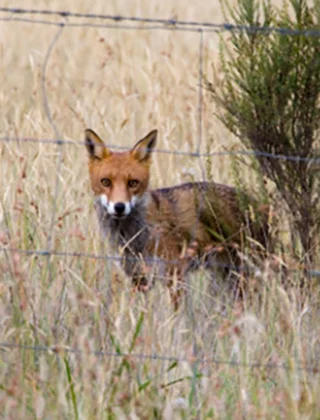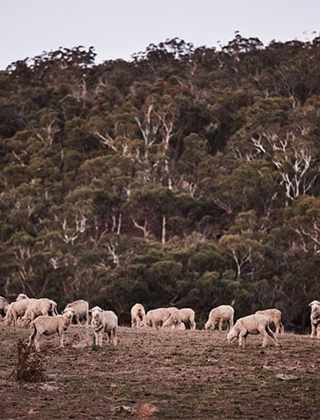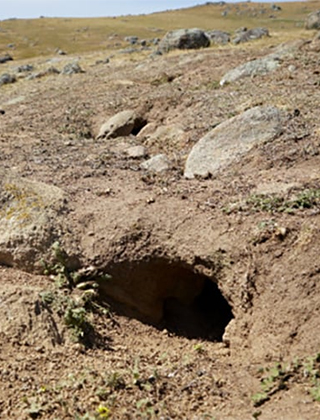Feral pig control: tips, advice & busted myths
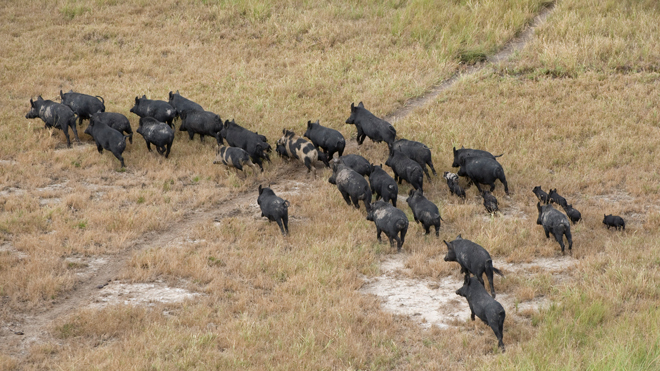
The population of feral pigs in Australia has increased dramatically during the past few years due to good seasonal conditions that have provided feral pigs with plenty of feed and water. In a recent AWI Extension NSW webinar, two experts provided woolgrowers with some best practice feral pig control tips and also busted some myths.
The rapid rise in numbers of feral pigs is causing significant concerns for farmers and other landholders across Australia.
The wool and sheep industries are directly affected by feral pigs, largely via predation of lambs, but also by damage to fences. Furthermore, feral pigs create environmental damage by wallowing and fouling water sources, turning over vast areas of soil when rooting for food, and facilitating the spread of weeds. There are about 150 species of threatened flora and fauna impacted by feral pigs.
Feral pigs are also carriers and spreaders of at least 45 known serious diseases and parasites including brucellosis and leptospirosis. They can also host Foot-and-mouth disease and African swine fever, that have the potential to devastate wool and livestock operations if the highly contagious diseases ever get into Australia. Of note to livestock producers, feral pigs wallow in water troughs, into which they transmit diseases that livestock can contract.
In March, AWI Extension NSW hosted a webinar to inform woolgrowers about best practice feral pig control. Presenting on the webinar were feral animal expert Dave Worsley of the Centre for Invasive Species Solutions (CISS) and community engagement specialist Darren Marshall who has been working with feral pigs for 20 years. Both are members of the Implementation Committee of the National Feral Pig Action Plan 2021-2031.
Why the increase in feral pig numbers?
Feral pigs don’t have an annual breeding cycle. If the conditions are good, which they have been during the past few years, feral pigs will just keep breeding, resulting in a high reproduction rate.
“Sows become sexually mature at 25 kilos, that’s under six months of age, and can be down to three months of age depending on food supply. They can turn off two litters every 12 to 15 months under ideal conditions, and those litter sizes will generally range between four and 10 piglets, 10 piglets in the better times,” Dave said.
“Critically, feral pigs need a crude protein percentage of 15% in order to breed at maximum functionality. Due to three years of La Niña, conditions have been good, providing feral pigs with plenty of quality food, so Australia has had an explosion in feral pig numbers.
“Although control programs do reduce population numbers, the programs haven’t been taking out enough feral pigs to get in front of the curve, meaning any reduction is only temporary and the medium- and long-term numbers are going up.”
In a ‘normal’ season, unless at least 75% of feral pigs are destroyed in a short period of time, there is no long-term effect on their population.
“But in ‘good’ seasons, like we have had across much of Australia, that percentage rises to at least 85%,” Darren said.
“There are a lot of myths about feral pigs; for example you often hear ‘they don't mix 1080 like they used to’, ‘the feral pigs all live in the National Park’, ‘this doesn't work, that doesn't work’, but the reality is that we are just not killing enough feral pigs. We are not taking enough of them out of the landscape to have the impact that we need to.”
“In good seasons, like we have been having, unless at least 85% of feral pigs are destroyed in a short period of time, there is no long-term effect on their population.”
- Darren Marshall
Evidence of predation
Feral pigs are an extreme generalist forager, eating a large volume and a wide variety of foods. Their main focus is on vegetation, however they will eat anything, including animals, be it worms, frogs, lizards or… lambs.
“If you’re not seeing the expected number lambs in the paddock, then you could very likely have a feral pig problem. The feral pigs might not be foraging, digging, rubbing etc where your animals actually are, so you need to be alert to all signs of feral pigs not just the more obvious ones. Monitoring and getting some cameras out is really important,” Dave said.
“Sometimes sheep producers will find that ‘an absence of evidence is evidence of feral pigs’ because the feral pigs will eat everything of the animal – they have extremely strong jaws and just completely crush the animal.”
Control principles and methods
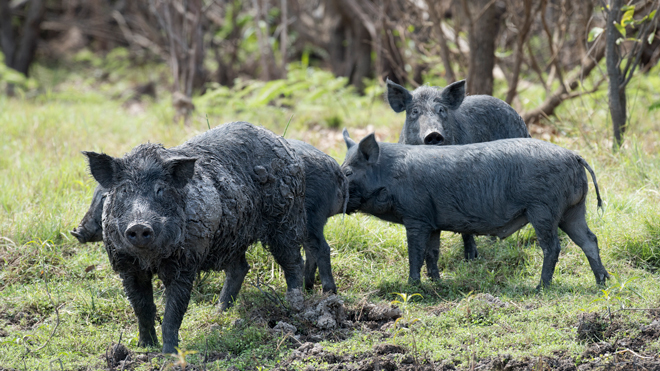
A combination of tools is essential for effective feral pig control, as no single technique will provide adequate long-term results. PHOTOS: JohnCarnemolla
The principles of a successful feral pig control program are very similar to the principles of control for other vertebrate pests such as a wild dogs and foxes. Success relies on a broadscale, co-ordinated effort of all landholders in a given area working co-operatively.
“It really worries me when land managers do feral pig control independently on their own property, because they are targeting only a small percentage of the feral pig population in the area. Feral pigs move across boundaries, so land managers need to work on a bigger scale than one property to have any impact at all,” Darren said.
It's also critical that this approach includes monitoring and communication components.
“If land managers are not communicating with their neighbours, working together, the control program will always fail,” Dave added.
A combination of control tools used as part of a coordinated effort by landholders is essential for effective feral pig control, because no single technique will provide adequate long-term results.
Control methods include ground and aerial baiting (the options are 1080 and HOGGONE®), aerial and ground shooting (possibly including the use of ‘Judas’ radio-collared feral pigs), trapping and exclusion fencing. Note: bounties do not work, they ultimately increase the feral pig population.
“For landscape scale control rather than individual property control, baiting and aerial shooting are the two control methods that I've seen as most effective across that larger area. The other control methods do have a place though so that we expose all the feral pigs to a control method that is best suited to them,” Darren said.
Dave said that if only one control program is undertaken each year, it is very unlikely to achieve the required 85% knockdown.
“What we really need to do in our feral pig control to be effective is what I call a ‘double tap’ which is two control programs within one life cycle which is about a four month period,” he said.
The suite of feral pig control techniques can be incorporated with control programs for other pest animals, such as wild dogs and foxes, to form an integrated pest management program. However, it is important to consider the impacts of the program on all target pest animals.
“If you are also trying to undertake a wild dog and a fox control program, feral pigs will vacuum up baits and there is not enough poison in them to have any impact so it's really just free feeding the feral pigs. If there is shooting of deer in your area, again it’s feeding feral pigs with an alternative to what we want them to eat,” Dave explained.
“What we really need to do in our feral pig control to be effective is what I call a ‘double tap’ which is two control programs within one life cycle which is about a four month period.”
- Dave Worsley
Aim to be the best restaurant in town
Feral pigs are gregarious which means they like to live in family groups; so mothers, sisters, nieces etc live together in a group. The boars will leave the mob when they are sexually mature and go off into bachelor herds.
Dave said it’s important to ensure family groups of feral pigs feel comfortable to keep coming to a location where control methods such as baiting and trapping are to be carried out.
“If we train feral pigs to think that they're our friends then it makes a big difference to the way that we can control them.”
- Dave Worsley
“It’s all about low stress feral pig handling. If we train feral pigs to think that they're our friends then it makes a big difference to the way that we can control them, than if we chase them around with dogs and knives and guns etc,” he said.
“The goal is to create the ‘best restaurant in town’, to give the feral pigs the best food so that their whole family group feels comfortable coming back for more – and then we can bait them, or trap them etc.”
Dave said feral pig control is a process and not an event.
“You need at least a week to go through the process of free feeding. Anyone can trap or poison a feral pig or two, but to be effective you need to get them to be comfortable feeding at a location of their choice, not our choice. So take the feed to the feral pigs,” he said.
“Put out the pile of grain in a likely location as a ‘sounder’, to see if the feral pigs want to feed there. If they want to feed there, proceed on. Don’t put out a trap or plan a poisoning station without making sure that the feral pigs actually want to eat there first.
“Soak the grain and pile it up in a heap so it stays moist and the feral pigs have got time to come on to it – and give them a full meal not a Mars bar so they don't need to go anywhere else to feed. If feral pigs are not familiar with your food source, it will take them time to learn that it is a food source and they can eat it.
“If you're trying to trap or poison, you’ll be more effective if you feed at the time of the year when there is less competition from other good food sources out there. So for instance, on the Northern Tablelands of NSW, winter is a tight time for food so you can very easily be the best restaurant in town. But further south, it would be better to open the best restaurant in town during the hot and dry summer.”
For trapping, when you’ve found a location where the feral pigs feel safe, set the trap with plenty of feed in it and the feral pigs will come. Free feed for at least a week to get the feral pigs comfortable before setting the gate, ensuring that they have ample feed for all.
“If you arrive on your trapping site and you've got a mob of feral pigs outside, don't be tempted to shoot two out of eight because you’ll be training six that you're not their friend, and they'll never come back,” Dave said.
“You can potentially put two traps side by side. Don't leave feral pigs in a trap for any great length of time, just long enough to draw other ones in.”
Feral pig movements explained
The season and time of year affects not only when to implement your control program, but also where to implement your program.
“Feral pigs can cluster in different parts of the landscape depending on the season, so you need to target your control efforts accordingly,” Darren said.
“For example, in an area that I’ve studied, the feral pigs clustered in autumn in one place, in winter in another place, and summer in another place, while in spring there was a lot of movement. So if you ran a successful baiting campaign in autumn, running another campaign in the same location might sound like a good idea, but if it is in summer the feral pigs might be across the other side of the valley.”
Darren said that feral pigs travel much smaller distances than people often think and they cover the country quickly.
“A sow’s ‘core home range’ can be down to the size of a football field and its ‘home range’ can be up to 4–5 km2. A boar’s ‘core home range’ can be down to 4 km2 and its home range up to up to 50 km2. In research using collaring data at Westmar in southern Queensland, a feral pig covered its entire home range every 15 hours which is much quicker than many people would have thought,” he said.
“In all the data we've analysed, neither the amount of rain nor the temperature has made any difference to feral pigs’ movement pattern.”
“When we base feral pig control techniques on facts rather than myth, we get much better results.
- Darren Marshall
Darren says that people often believe feral pigs live in the National Park and they travel great distances to feed and then go back to the National Park to rest and to shelter.
“However, our research shows that feral pigs don't really go into the National Park much at all. The 15% crude protein that they need to get for optimum breeding is in productive areas, not in the National Park. It’s important to get rid of the myth that they live in scrubby areas and the myth that they travel long distances,” he said.
Dave added that feral pigs lack sweat glands so they need to go to water twice a day and access shade to cool down in hot weather.
“The need for water limits how far they can travel from water. In a good season, they can spread out significantly, but when we get into extremely dry times it pulls them back and makes them more concentrated, which makes them easier to control.”
More information:
- The webinar recording is available on: www.awiextensionnsw.com/webinars
- PestSmart resources: www.pestsmart.org.au/toolkits/feral-pigs
- National Feral Pig Action Plan: www.feralpigs.com.au
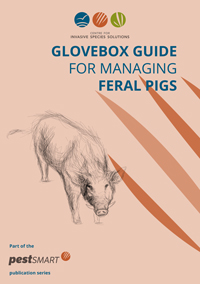
The CISS’s 32-page best practice management guide ‘Glovebox Guide for Managing Feral Pigs’, available on the PestSmart website, was co-funded by AWI.
Monitoring feral pigs using FeralPigScan
FeralPigScan is a free digital resource that Australian sheep and wool producers, plus other landholders and stakeholders, can use to record and access information about feral pig populations in their local area.
What to record:
- Feral pig activity and sightings
- Damage, such as predation, crop damage or soil disturbance
- Control activities
- Photos from monitoring cameras.
Benefits of using FeralPigScan
- Develop a property or local area map of feral pig activity to guide control efforts
- Work together with your neighbours to undertake coordinated control
- Notify your local community or landholder group about feral pig activity
- Send alerts to nominated people, such as neighbours or biosecurity authorities.
FeralPigScan is available as an interactive website and mobile phone app, both of which have been designed to be simple to use.
FeralPigScan is part of the FeralScan™ suite of tools for monitoring pest animals. It receives funding from AWI, the Department of Agriculture, Fisheries & Forestry and NSW Department of Primary Industries through CISS.
More information: www.feralpigscan.org.au
This article appeared in the June 2024 edition of AWI’s Beyond the Bale magazine. Reproduction of the article is encouraged.






